Abstract
Background
The aim of our study was to optimize and establish erythropoietin (EPO) enzyme linked immunosorbent assay (ELISA) system.
Methods
We prepared several monoclonal and polyclonal antibodies specific to human-EPO. The best combinations of antibodies for coating and detecting antibodies were selected for the establishment of ELISA. We tested several methods such as a competitive EIA and a sandwich ELISA.
Results
The best sandwich ELISA was optimized compared to competitive EIA when purified polyclonal antibody (PoAb) was used as a coating antibody and biotinylated PoAb as a detecting antibody. This sandwich ELISA easily detected EPO when PoAb pairs were used compared to the ELISA using monoclonal antibody and PoAb. There were no significant differences between the effects of various blocking solutions on the performance of sandwich ELISA using biotinylated antibody. The ELISA system using PBST containing 3% BSA as a blocking solution can sensitively detect EPO (10 mU/mL) in a broad range of EPO concentrations (10–2,000 mU/mL) and there were cross-reactions with other cytokines).
Go to : 
References
1. Abu-Qare AW, Abou-Donia MB. High performance liquid chromatographic determination of diazinon, permethrin, DEET (N, N-diethyl-m-toluamide), and their metabolites in rat plasma and urine. Fresenius. J Anal Chem. 2001; 70:403–7.
2. Chamkasem N, Hill KD, Sewell GW. High-performance liquid chromatographic column-switching technique for the determination of intermediates of anaerobic degradation of toluene in ground water microcosm. J Chromatogr. 1991; 587:185–91.

3. Cass QB, Oliveira RV, De Pietro AC. Determination of gossypol enantiomer ratio in cotton plants by chiral higher-performance liquid chromatography. J Agric Food Chem. 2004; 52:5822–7.

4. Klvanova J, Brtko J. Selected retinoids: determination by isocratic normal-phase HPLC. Endocr Regul. 2002; 36:133–41.
5. Cousino MA, Jarbawi TB, Halsall HB, Heineman WR. Pushing down the limits of detection: molecular needles in a haystack. Anal Chem. 1997; 69:544–9A.
6. Chen SF, Xu Y, Ip MP. Electrochemical enzyme immunoassay for serum prostate-specific antigen at low concentrations. Clin Chem. 1997; 43:1459–61.

7. Messina GA, Torriero AA, De Vito IE, Olsina RA, Raba J. Continuous-flow/stopped-flow system using an immunobiosensor for quantification of human serum immunoglobulin G (IgG) antibodies to Helicobacter pylori. Anal Biochem. 2005; 337:195–202.
8. Qu Y, Berghman LR, Vandesande F. An electrochemical enzyme immunoassay for chicken luteinizing hormone: extension of the detection limit by adequate control of the nonspecific adsorption. Anal Biochem. 1998; 259:167–75.

9. Wang X, Chen F, Wan PJ, Huang G. Development of monoclonal antibody-based enzyme-linked immunosorbent assay for gossypol analysis in cottonseed meals. J Agric Food Chem. 2004; 52:7793–7.

10. Zola H. Monoclonal antibodies: Production, purification, analysis, quality control, storage, and distribution. In. Zola H, editor. Monoclonal antibodies: A manual of techniques. Boca Raton: CRC Press, FL;1987. p. 70–6.
11. Wang X, Plhak LC. Monoclonal antibodies for the analysis of gossypol in cottonseed products. J Agric Food Chem. 2004; 52:709–12.

12. Laemmli UK. Cleavage of structural proteins during the assembly of the head of bacteriophage T4. Nature. 1970; 227:680–5.

13. Conkerton EJ, Frampton VL. Reaction of gossypol with free epsilon-amino groups of lysine in proteins. Arch Biochem Biophys. 1959; 81:130–4.
Go to : 
 | Fig. 1.Competitive enzyme immunoassay for EPO by coincubating EPO with HRP-labelled EPO (A) or biotin labelled EPO (B) onto the coated polyclonal antibody. Polyclonal antibody (PoAb) was coated onto the wells and then blocked with blocking solution. Then biotin-labelled EPO (or HRP-labelled EPO) and free EPO were coincubated in the PoAb coated wells in order to perform a competitive enzyme immunoassay. The wells treated with biotinylated PoAb was further incubated with streptavidin-HRP and washed with PBST. The HRP activity was then detected with TMB substrate as described in “Materials and Methods” section. Error bars display the mean±standard deviation of three determinations. |
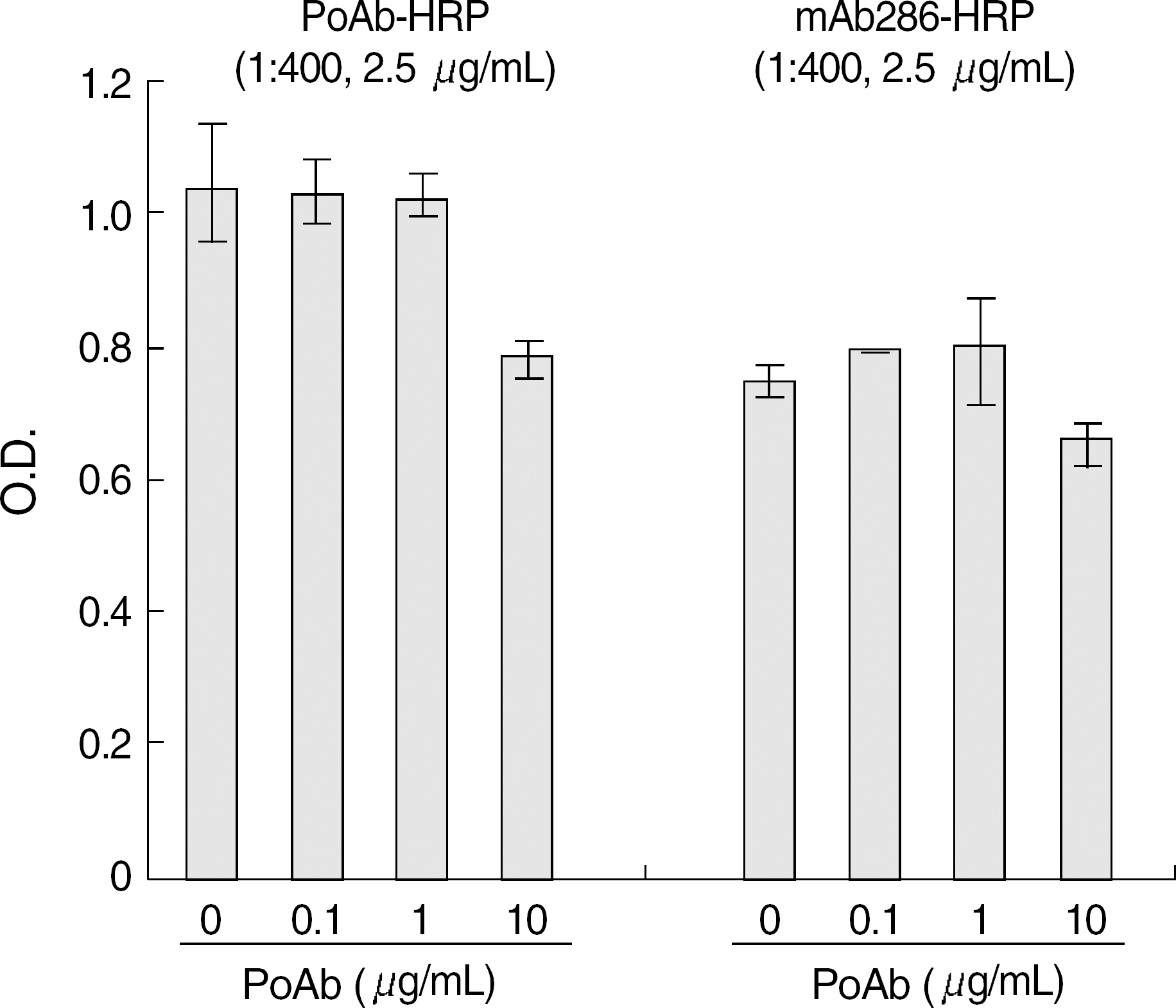 | Fig. 2.Binding inhibition assay for selecting antibody pairs in the performance of EPO sandwich ELISA. EPO was coated onto the wells and then blocked with blocking solution. Then a constant amount of PoAb-HRP (1:400) or mAb-HRP (1:400) was coincubated with various concentrations of PoAb for 1 hr and washed with PBST. The wells treated with biotinylated PoAb was further incubated with Streptavidin-HRP and washed with PBST. The HRP activity was then detected with TMB substrate as described in the “Materials and Methods” section. Error bars display the mean± standard deviation of three determinations. |
 | Fig. 3.Sandwich ELISA using a biotinylated antibody (A) and HRP-conjugated polyclonal antibody (B). PoAb was coated into a microtiter plate and incubated with EPO for 1 hr. Then biotinylated Ab, or PoAb-HRP was incubated for 1 hr. The wells treated with biotinylated PoAb was further incubated with streptavidin-HRP and washed with PBST. The HRP activity was then detected with TMB substrate as described in the “Materials and Methods” section. Error bars display the mean±standard deviation of three determinations. |
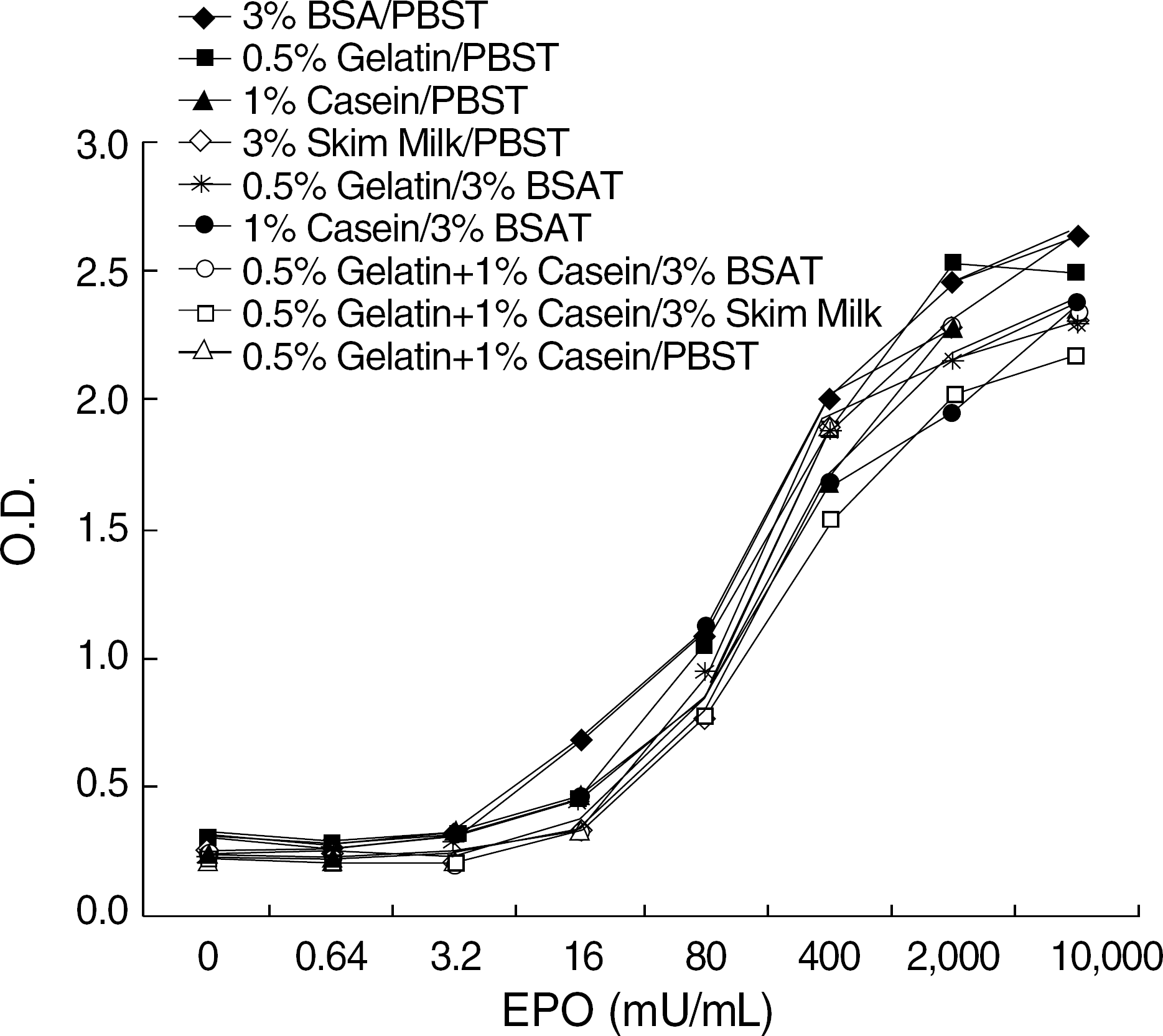 | Fig. 4.The effect of various blocking solutions on the performance of sandwich ELISA using biotinylated antibody. PoAb was coated into microtiter plate, incubated with various blocking solutions, and incubated with EPO for 1 hr after washing. Then biotinylated PoAb was incubated for 1 hr followed by further incubation with streptavidin-HRP. After washing with PBST, the HRP activity was detected with TMB substrate as described in the “Materials and Methods” section. Error bars display the mean±standard deviation of three determinations. |
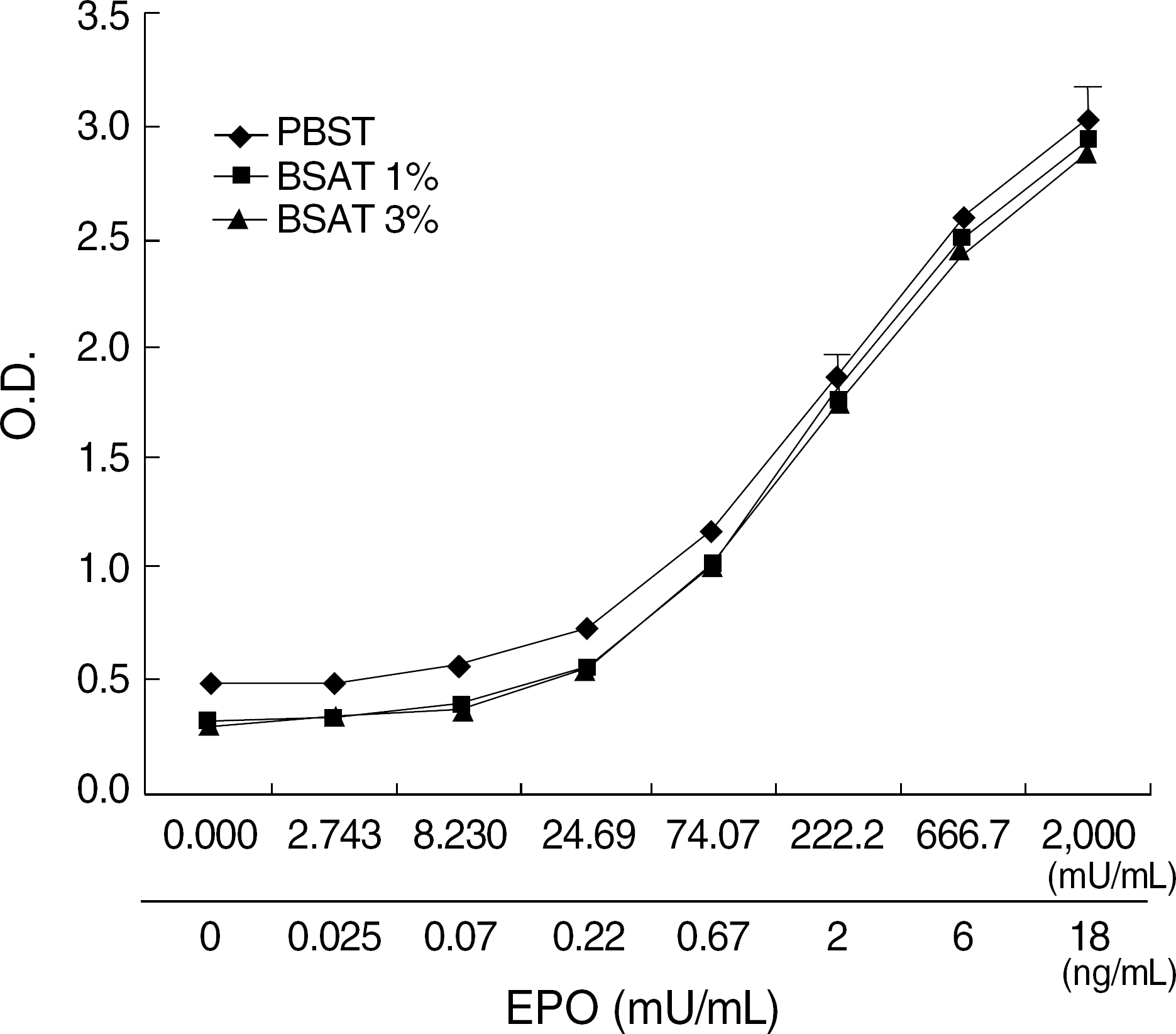 | Fig. 5.The effect of various matrices on the performance of sandwich ELISA using biotinylated antibody. PoAb was coated into microtiter plate and incubated with EPO diluted with various matrices for 1 hr. Then biotinylated PoAb was incubated for 1 hr followed by further incubation with streptavidin-HRP. After washing with PBST, the HRP activity was then detected with TMB substrate as described in the “Materials and Methods” section. Error bars display the mean±standard deviation of three determinations. |
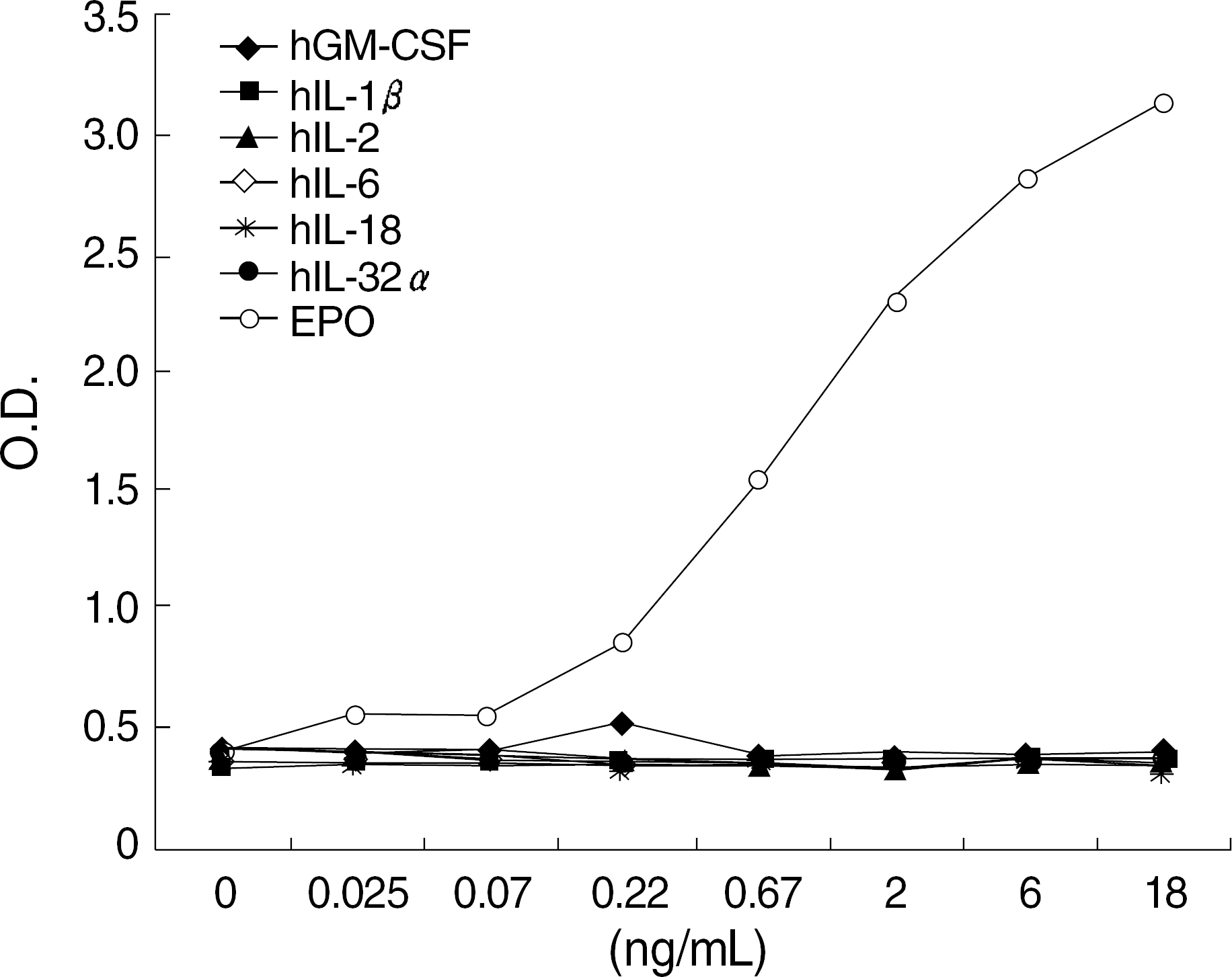 | Fig. 6.The specificity of sandwich EPO ELISA. PoAb was coated into a microtiter plate and incubated with EPO or other glycoprotein cytokines for 1 hr. Then biotinylated PoAb was incubated for 1 hr followed by further incubation with streptavidin-HRP. After washing with PBST, the HRP activity was detected with TMB substrate as described in the “Materials and Methods” section. Error bars display the mean±standard deviation of three determinations. |




 PDF
PDF ePub
ePub Citation
Citation Print
Print


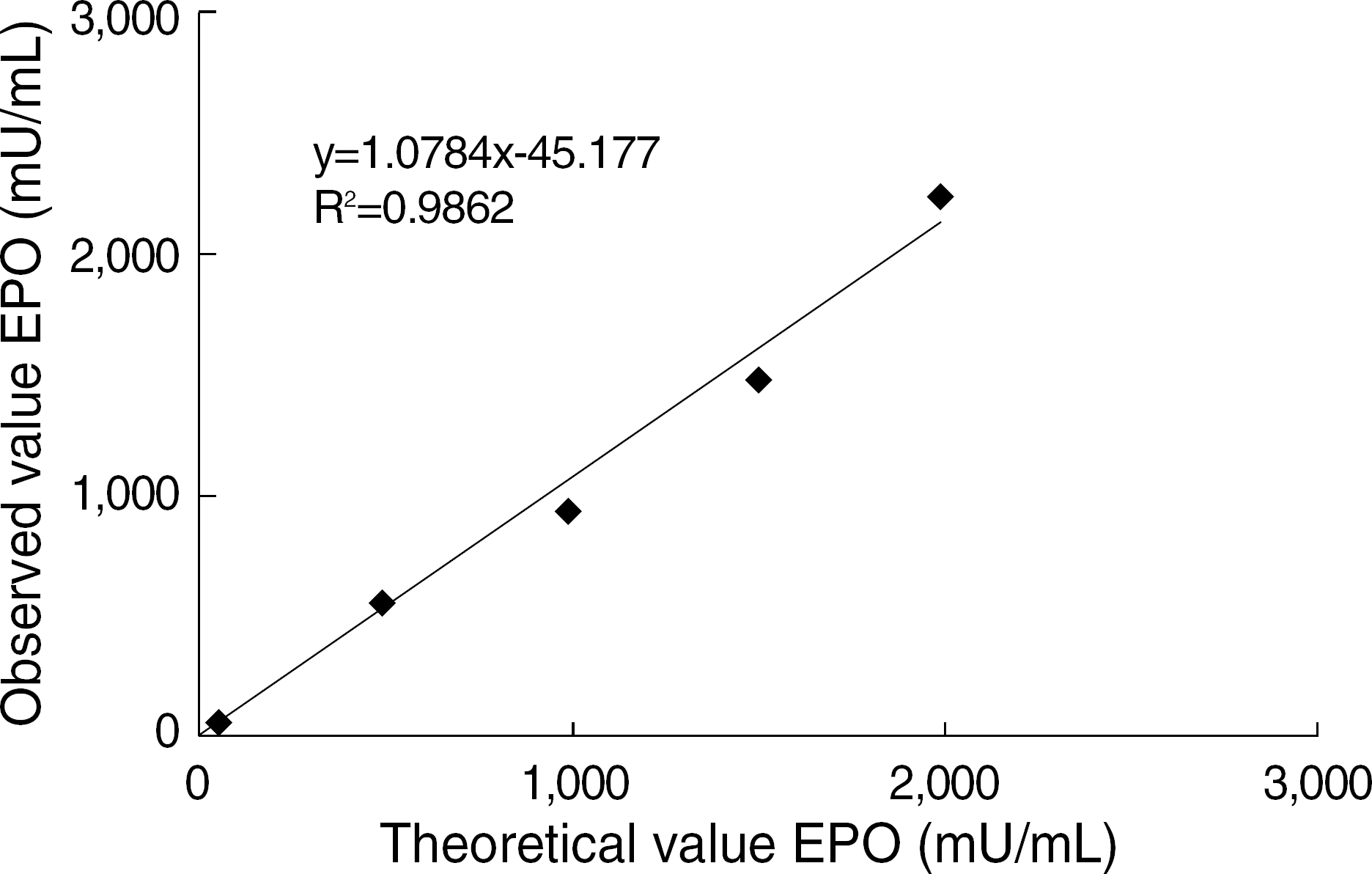
 XML Download
XML Download